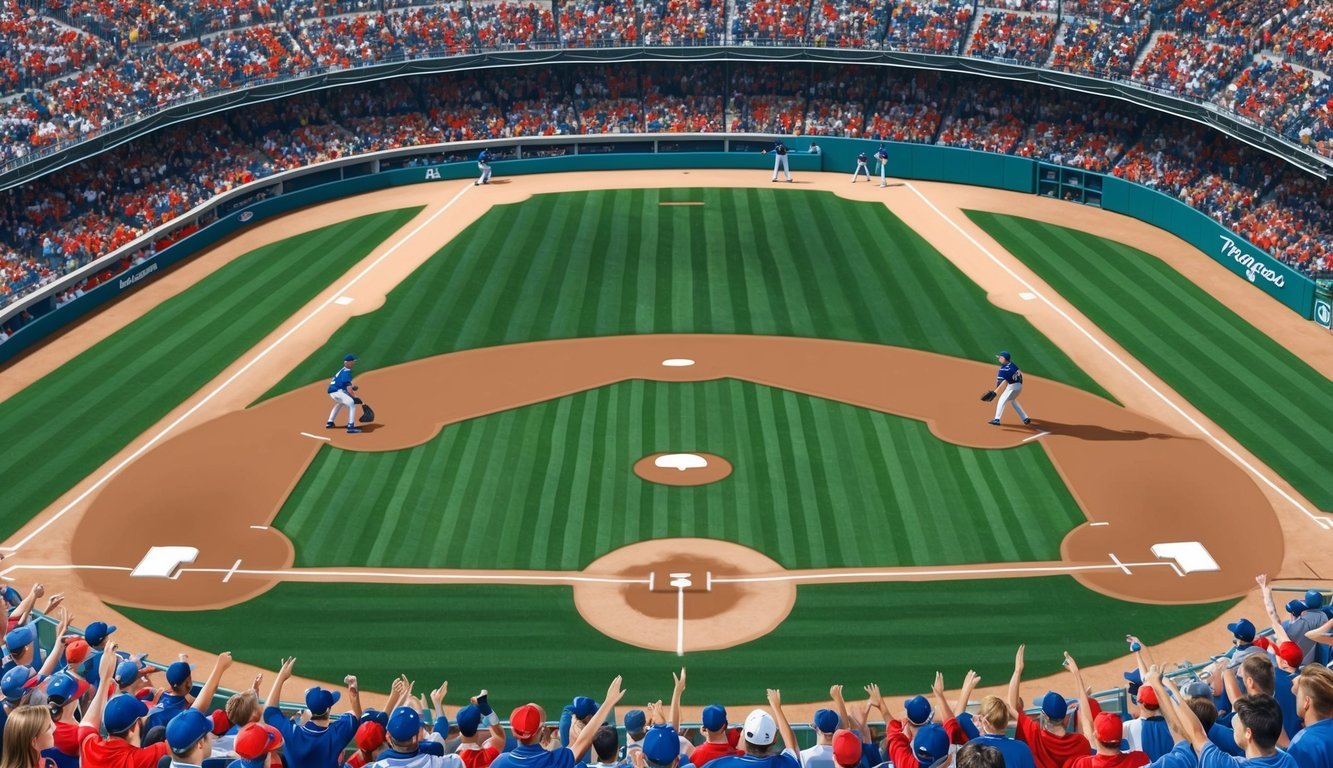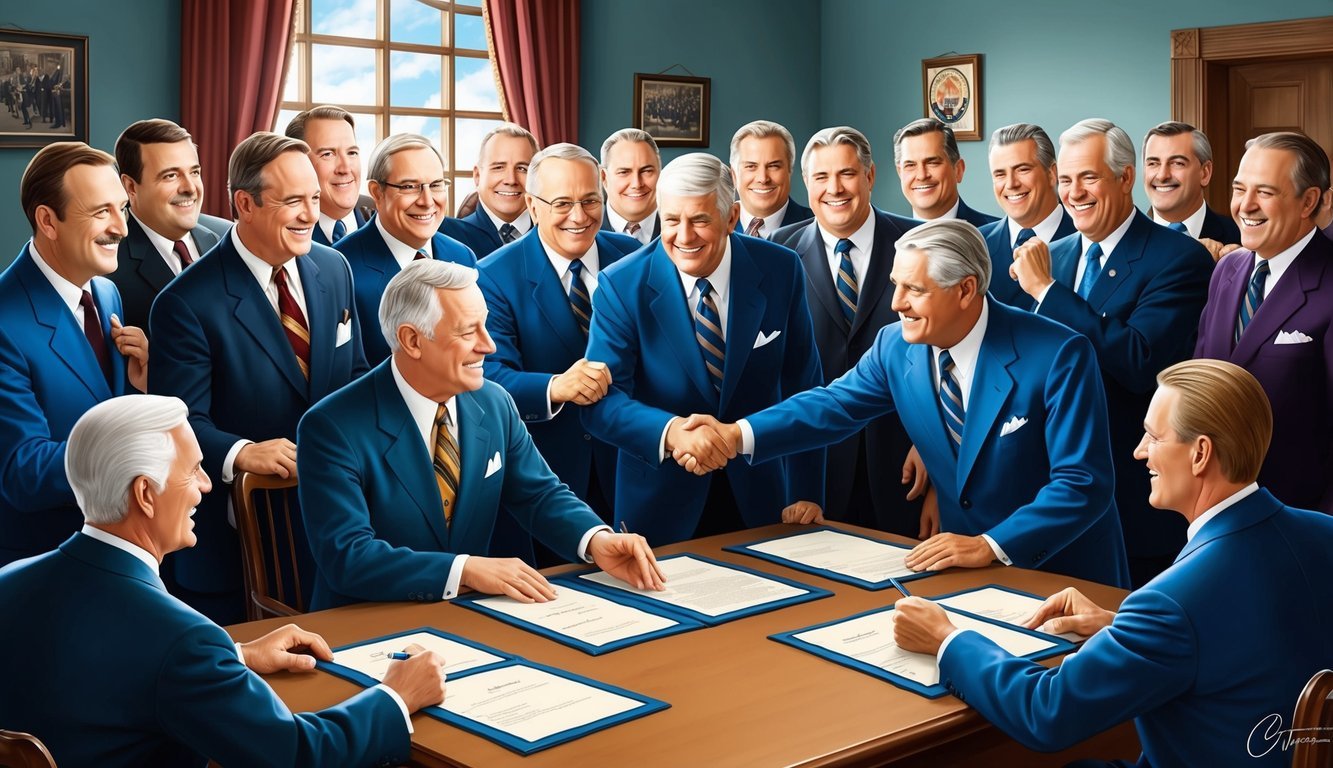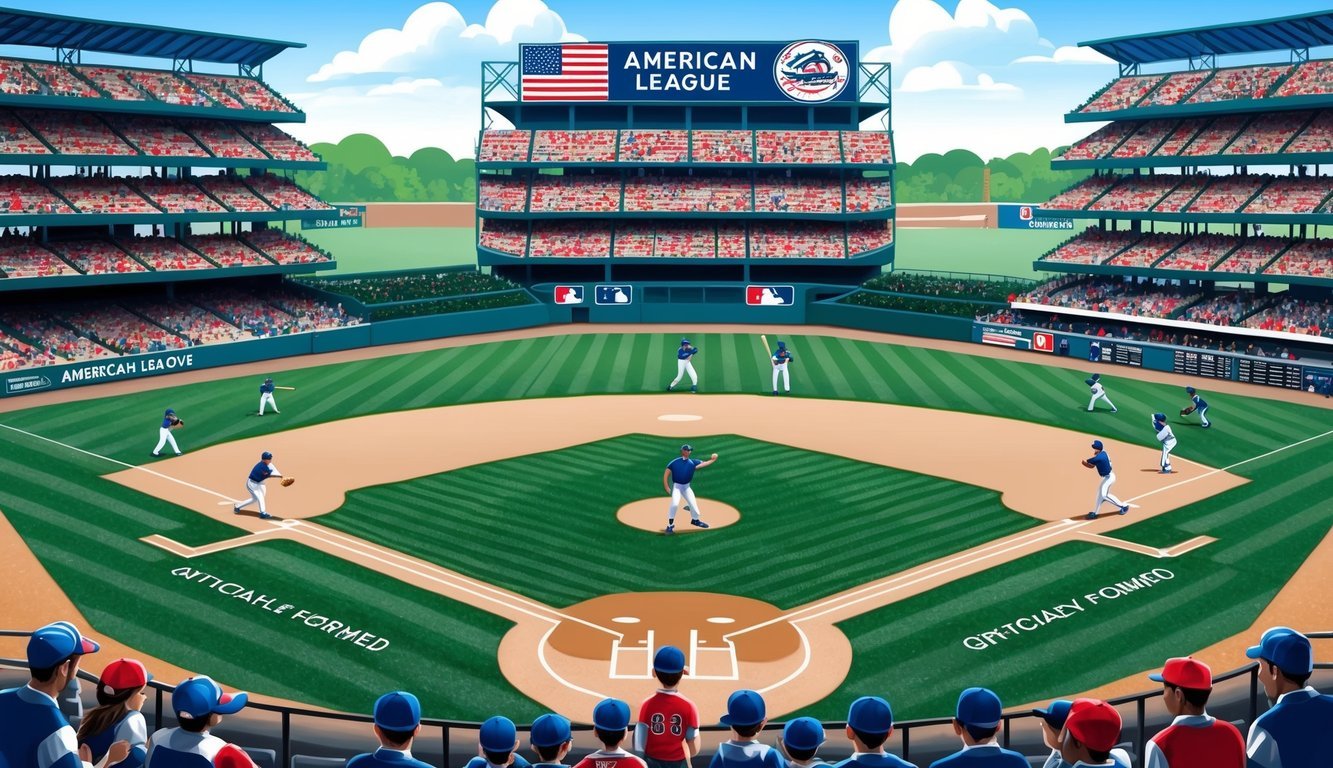The American League formed in 1901 and marked a pivotal moment in baseball history.
It emerged as a challenger to the established National League.
This new organization brought fresh competition and excitement to professional baseball.
The American League’s creation reshaped the landscape of America’s favorite pastime, expanding major league baseball beyond the National League’s eight teams. It introduced new franchises in cities like Boston, Chicago, and Detroit, giving more fans across the country access to top-level baseball.
The league’s founders, led by Ban Johnson, saw an opportunity to capitalize on baseball’s growing popularity and fill the void left by the National League’s contraction.
The American League’s arrival sparked fierce competition between the two major leagues.
This rivalry led to bidding wars for players, rule changes, and eventually the creation of the World Series.
The emergence of the American League not only changed the structure of professional baseball but also helped cement the sport’s place in American culture.
The Origin and Founding Fathers of the American League
The American League’s creation marked a pivotal moment in baseball history.
Its founders reshaped professional baseball and introduced fierce competition to the sport’s landscape.
Ban Johnson and the Western League
Ban Johnson, a visionary sports journalist, played a crucial role in the American League’s formation.
He transformed the minor Western League into a major force in professional baseball.
Johnson became league president in 1894 and worked tirelessly to improve the league’s reputation.
He recruited respected owners and placed teams in larger cities.
Charles Comiskey, owner of the St. Paul Saints, moved his team to Chicago.
They became the White Stockings, later known as the White Sox.
Johnson’s strategic moves paid off.
The Western League’s popularity grew, rivaling the established National League.
Redefining the Major League Landscape
On January 28, 1901, the American League officially came into existence.
It boldly declared itself a major league, challenging the National League’s monopoly.
The new league introduced several innovations:
- 140-game schedule
- 14-man rosters
- Players’ union
Johnson strategically placed teams in key cities:
- Chicago White Stockings
- Detroit Tigers
- Cleveland Indians (now Guardians)
These moves sparked intense competition with the National League.
The American League quickly gained fan support and attracted top talent.
Its success forced the National League to recognize it as an equal.
This rivalry reshaped baseball, leading to the modern two-league structure we know today.
Expansion and Rivalry

The American League’s growth and competitive spirit shaped baseball’s landscape in the early 20th century.
New teams joined the ranks, fueling intense competition with the established National League.
Early Team Additions and Competition
The American League started with eight teams in 1901.
By 1902, it welcomed the St. Louis Browns (later Baltimore Orioles) and Milwaukee Brewers (who became the St. Louis Browns in 1902).
These additions strengthened the league’s presence in key markets.
The new teams brought fresh talent and excitement to the sport.
Fans flocked to see rising stars and local rivalries develop.
The expanded league offered more opportunities for players and increased baseball’s popularity across the country.
Rivalry with the National League
The American League’s rapid growth sparked a fierce rivalry with the National League.
Both leagues competed for players, fans, and media attention.
This healthy competition drove innovations in the game and improved conditions for players.
The rivalry reached its peak during player contract disputes.
Teams from both leagues tried to outbid each other for top talent.
This “baseball war” led to higher salaries and better treatment for players.
Ultimately, the rivalry benefited the sport.
It pushed both leagues to improve and expand, laying the groundwork for Major League Baseball as we know it today.
Innovations and Contributions

The American League introduced groundbreaking changes that reshaped professional baseball.
These innovations altered player dynamics and financial structures within the sport.
One significant change was the adoption of the designated hitter rule, which transformed offensive strategies and extended the careers of many players.
Additionally, shifts in revenue sharing and free agency rules gave athletes more control over their earnings, though these adjustments also contributed to disputes over salaries and contracts.
Over time, disagreements between team owners and players led to labor strikes in baseball, highlighting the ongoing tension between financial interests and the sport’s tradition.
Introducing the Designated Hitter Rule
In 1973, the American League implemented the designated hitter (DH) rule.
This allowed teams to use a player to bat in place of the pitcher.
The DH rule aimed to boost offense and add excitement to games.
It created a new position for players who excelled at hitting but struggled defensively.
Aging stars found extended careers as designated hitters.
The rule sparked debates about strategy and tradition in baseball.
The National League initially rejected the DH, creating a unique difference between the two leagues.
This distinction added intrigue to interleague play and the World Series.
Impacts on Player Salaries and Contracts
The AL’s formation and subsequent growth led to significant changes in player compensation.
Competition between leagues sparked bidding wars for top talent.
Free agency, introduced in the 1970s, further transformed the financial landscape.
Players gained more bargaining power, leading to substantial salary increases.
The AL’s expansion and popularity contributed to rising team revenues.
This allowed clubs to offer larger contracts to star players.
Long-term, guaranteed contracts became more common.
Teams invested heavily in proven performers and promising prospects.
The salary structure evolution attracted more athletes to baseball, enhancing the talent pool and competitiveness of the league.
Historic Moments and Legendary Figures

The American League’s early years were marked by extraordinary players, visionary managers, and unforgettable events that shaped baseball history.
These individuals and moments laid the foundation for the league’s enduring legacy.
Iconic Players and Management
Cy Young dominated the mound in the AL’s inaugural years, showcasing his legendary pitching prowess.
Nap Lajoie dazzled fans with his hitting and fielding skills, becoming one of the league’s first superstars.
Connie Mack, the Philadelphia Athletics’ long-time manager, built dynastic teams and revolutionized baseball strategy.
His innovative approach influenced the game for generations.
Jimmy Collins, the Boston Americans’ (later Red Sox) star third baseman and manager, helped establish the AL as a formidable competitor to the National League.
Memorable Games and Events
The first World Series in 1903 pitted the AL champion Boston Americans against the NL’s Pittsburgh Pirates, cementing the league’s status.
Babe Ruth’s emergence with the Red Sox, before his famous move to the Yankees, electrified baseball and set new standards for power hitting.
The Washington Senators’ surprise 1924 World Series victory captivated fans and showcased the league’s competitive balance.
John T. Brush’s refusal to allow his New York Giants to face the AL champions in 1904 led to changes ensuring future World Series would be played annually.
The American League Today

The American League is a cornerstone of Major League Baseball.
Fifteen teams compete fiercely for a chance at the World Series title each year.
Playoffs have expanded, now including wild card teams.
This format creates more excitement and opportunities for clubs to reach the postseason.
Team owners continually seek ways to boost attendance and engagement.
Many stadiums offer enhanced fan experiences with gourmet food options and interactive zones.
Schedules are carefully crafted to balance competitive fairness and travel demands.
Interleague play adds variety, allowing fans to see stars from both leagues.
The American League boasts some of baseball’s most storied franchises:
- New York Yankees
- Boston Red Sox
- Chicago White Sox
These teams, along with newer powerhouses, drive ticket sales and TV ratings.
The league’s popularity helps maintain its status as a premier professional sports organization.
Player development remains crucial.
Farm systems nurture talent, ensuring a steady pipeline of exciting prospects reaching the big leagues.
Technology has changed how fans follow their favorite teams.
Mobile apps provide real-time updates, while social media connects players directly with supporters.
